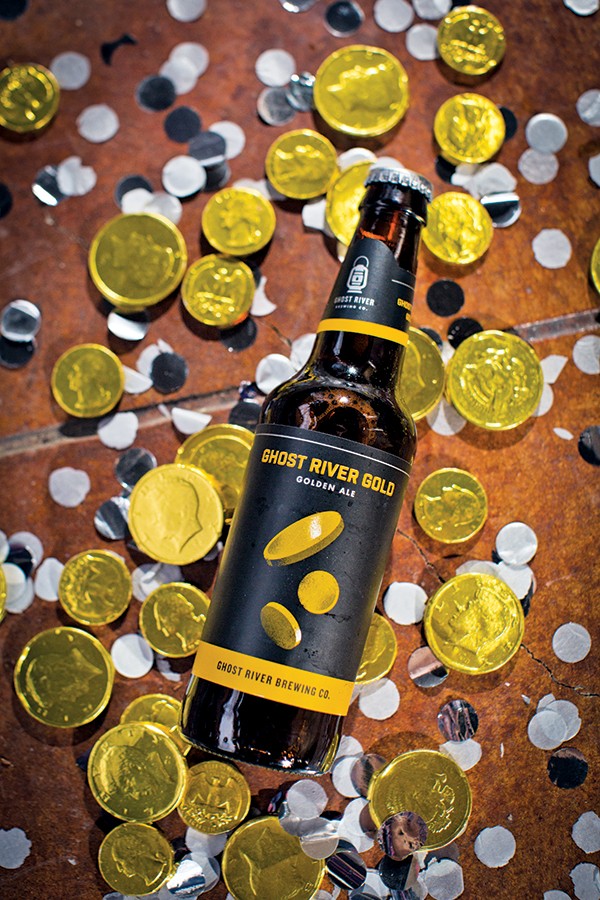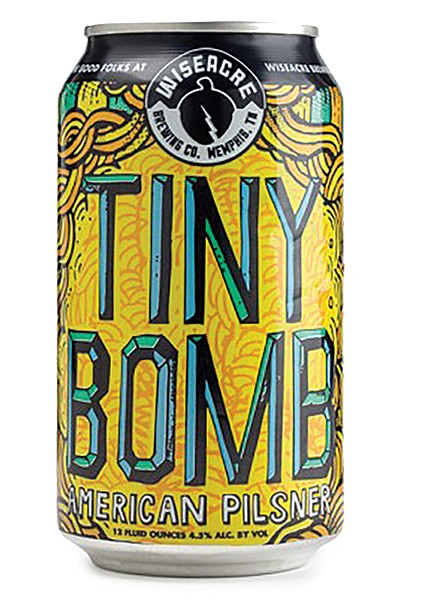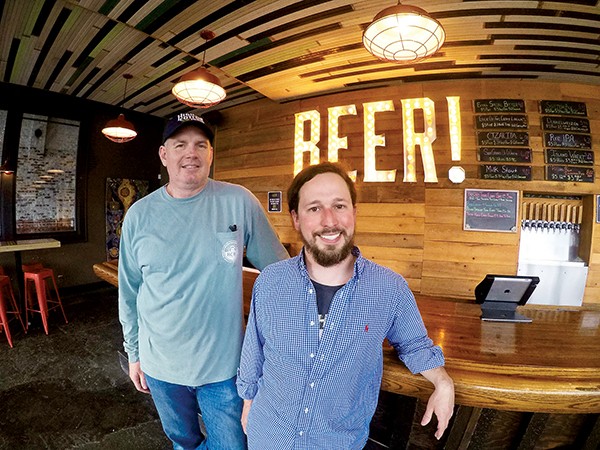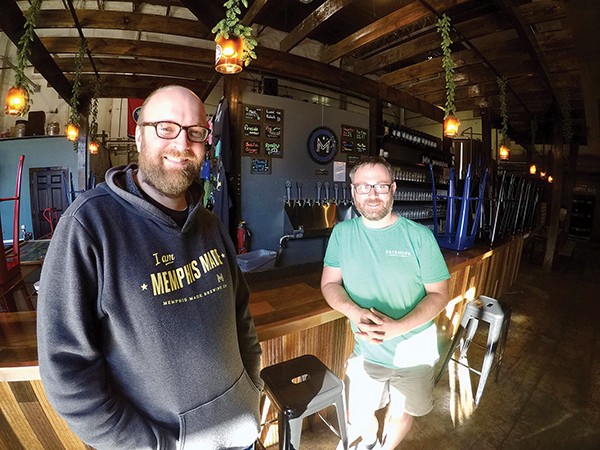Ghost River Gold is the best beer in Memphis, according to the nearly 1,500 voters in The Memphis Flyer & Aldo’s Beer Bracket Challenge.
The Golden Ale itself is light, delicate even, but the beer brand is tough and trusty and survived the early days as a pioneer in the Memphis craft beer wilderness.
Long before there were craft breweries everywhere, Ghost River went solo, a scrappy Memphis beer taking on the national brands. Ghost River persevered, pumping oceans of what was originally called Ghost River Golden Ale into the market and, judging from the voting, into the hearts of a legion of fans.
“Overjoyed,” was how Ghost River’s head brewer Jimmy Randall described his feeling on hearing about Gold’s win. “I’m just so grateful for the continuing support we’ve received from our hometown.”
 Justin Fox Burks
Justin Fox Burks
Memphis did, indeed, give Ghost River a lot of love during our week of voting. It was a 16-beer bracket, featuring brews from all four local breweries: Memphis Made, Wiseacre, High Cotton, and Ghost River. Two Ghost River beers — Gold and Grindhouse — made it to the final round. Gold won by only a few votes, but Ghost River was the winner, either way.
The Flyer‘s Beer Bracket Challenge was broken up into four categories — light beer, dark beer, IPAs, and seasonals. We asked our breweries what beers they wanted to represent them in those categories. We knew, though, that a Kölsch couldn’t (and shouldn’t) compete head to head with a different style, like a pilsner. So, to ensure some kind of objectivity, I donned a blindfold and picked the match-ups out of my red, Bass Pro drinking hat at Aldo’s Pizza Pies Downtown on Facebook Live.
With the bracket set, our voters did the rest. Hundreds of votes were cast during each round, for a final total of about 1,500 individual voters.
Yes, we know we’re not the first to “bracket-ize” beers. The idea has been floated in other alt weeklies around the country. Heck, the Memphis Craft Beer blog ran Malt Madness in 2015. Consider our hats tipped all around.
Running such a bracket is not without controversy. Beer styles are very different. Flavor choices — the brewing arts in general — are subjective. Our bracket was “just a popularity contest,” we were told. To which we say, hell yes! At its heart, that’s exactly what this was. Take it for what it is: fun.
Thanks to this story, I got to get reacquainted with our local breweries. Except for Ghost River, they all opened for business in 2013, and after four years, they’re all still dedicated to making the best beer they can.
But the craft beer boom is continuing. Look for one, possibly two, new breweries to pop up this year. Meddlesome Brewing, in Cordova, is planning to open this spring or summer. Crosstown Brewing pulled a $1.2 million building permit last week for its new building at (you guessed it) Crosstown Concourse.
Meanwhile, here’s a little fresh-brewed news on our breweries.

Wiseacre Brewing: The Tale of Tiny Bomb
Davin Bartosch was making coffee. Kellan, Davin’s brother and business partner, was chatting up The Memphis Flyer reporter in the Wiseacre break room. Davin, however, was making coffee with a loving focus that afforded no bandwidth for small talk until that coffee was made. If it’s anything like their beers, I thought, that’s going to be some damn good coffee.
Employees buzzed around the brewery, watching complicated brewing apparatus, answering phones, filing paperwork, or minding the bar. Kellan said the company now has about 20 full-time employees. They’re characters, every one, he said, but also hard workers who “really helped build this.”
The brothers long dreamed of opening a brewery and doing it in Memphis. It was realized in 2013, and they’ve gone full-steam ever since. Wiseacre is a formidable force in Memphis craft beer, and their beers are now sold in Tennessee, Arkansas, Mississippi, Louisiana, Illinois, and Pennsylvania. But their success has led to a happy problem: They’ve run out of room to make more beer.
“We can’t put any more tanks in the building,” Kellan said. “So, we’ve heard from people in Alabama, Georgia, Ohio, California, Florida — places that we could really pursue — but we currently can’t do anything else in our building in terms of production.”
Wiseacre is still mulling a move to expand their operation to the Mid-South Coliseum, but the Bartosches said no decision on that has been made. But, Kellan said, they’re happy as things are now. They love focusing on Memphis and making tons of Tiny Bomb, Ananda (the two best-selling Tennessee-made beers in the state, Kellan said), and Gotta Get Up to Get Down.
Beer names that spring from Wiseacre are routinely unusual: Men, Not Machines, Azazel, Neon Brown, and Unicornicopia. Even Adjective Animal is a meta-play on beer-naming conventions.
“I think our branding strategy is to either be clever or stupid, in the Beavis and Butthead kind of way, where it’s funny because it’s so dumb,” Kellan said.
But the boys were clever when it came to naming Tiny Bomb, which seems like the most basic, everyday, poundable drinker. But it’s more complicated than that (really).
Davin dreamed up and developed Tiny Bomb, a pilsner, years before Wiseacre opened. It came from his frustration with people “always drinking Bud Light.” “They’d say it was low in calories, so they could drink many of them at a time,” Davin said. “So, I thought, I’m going to find a way to satisfy everybody. So, tiny alcohol, tiny calories, flavor bomb.”
Tiny Bomb is suitable for slamming on a hot day, Davin agreed, but, being a light style, it is also delicate and a challenge to brew.
Kellan thought Davin was joking when he said he wanted to brew a pilsner for Wiseacre. The style was unfashionable at the time. But Davin stuck to Tiny Bomb, and now pilsners are en vogue.
“(Davin) knew it a decade ago, and we’re just now getting it,” Kellan said. “(Vincent) van Gogh died before people liked his art. Thankfully, Davin is still alive to see people enjoy Tiny Bomb.”
 Toby Sells
Toby Sells
High Cotton’s Ross Avery (left) and Ryan Staggs
High Cotton: A Scottish Shocker
Ryan Staggs is flummoxed, happily flummoxed.
Scottish Ale, a beer he developed in his garage, is High Cotton Brewing’s best-selling beer. But he doesn’t know why.
“It’s crazy!” Staggs said. “Who would have thought that a dark beer like that would have been (so successful).”
When High Cotton opened in 2013 in the Edge neighborhood, Staggs’ Scottish Ale was the only recipe all three brewery owners decided was ready to go without further tweaking.
“It was money from the get-go,” said co-owner Ross Avery.
Staggs said Scottish is easy to drink but a challenge to “make it, ferment it, and take care of it.” He says the style is “not really exotic” and “super traditional.” There’s no crazy yeast strain needed and no crazy ingredients.
“There’s no Scottish ales with mango or spruce tips,” Staggs joked.
But the style demands a brew done “exactly right,” or “the flaws come through pretty quickly,” Staggs said. He tips his hat to the macro brewers (Bud, Miller, and Coors) for making “a lager that at least tastes consistent. Maybe it’s not good, but it tastes consistent. That’s a feat in itself.”
The process produces a beer with a clean finish, Staggs said, “But it’s also a robust enough style where it’s still kind of rich, and caramely; it’s toffee, it’s toasty, and slightly roasty. I know that — sorry [Beer Judge Certification Program] — people are like, Scottish ales aren’t roasty! But roasted barley is what lends that flavor and what people perceive as roasty, and that is absolutely traditional in the brewing process.”
Staggs brewed at home for about five years before helping to found High Cotton. His training and experience as a civil engineer launched his respect for “the nerdy science behind brewing beer.” Copious notes and numerous iterations helped him refine the recipe, and it has paid off.
“What we drink today was kind of the final result of that [research and development] at my house,” Staggs said.
Having a brewery, a taproom, and beers for sale in Kroger are dreams come true for Staggs. But he said he couldn’t have imagined it would have been his Scottish that won the day.
“It’s sort of a gateway to craft beer for Memphians,” said Avery. “They had experience [with craft beer] with Ghost River Golden. So, we weren’t going to make another golden [ale]. And now it’s become our best seller.”
Avery said, “The summer before last, the temperature really started spiking up. I thought, a dark beer in the summertime? And yet sales remained steady. All I could imagine were people sitting in dark bars where it was cold.”
High Cotton recently expanded its seating capacity with a back bar that has huge windows looking into the brew house. Staggs said it’s always available during taproom hours and for private events. He said the company is experimenting with some new beers and is planning to be in new cans soon.
 Toby Sells
Toby Sells
Memphis Made’s Andy Ashby (left) and Drew Barton
Memphis Made: A Fireside Mystery
Bombers on a bottling line. That was the first thing I noticed on a visit to Memphis Made last week.
“Is that a temporary bottling line?” I asked, pointing at the machine.
“I mean, it’s temporary, as in it will run until we break it,” said Drew Barton, co-founder and head brewer at Memphis Made.
Memphis Made is the only Big Four Memphis brewery without a regularly available packaged product in local stores. They have done specialty bombers (750 milliliter bottles), and they canned up their Gonerfest IPA last year in a one-off deal. But the permanent bottling line will make packaged sales a more permanent fixture.
Those bottled beers will be exclusively high-gravity, Barton said. The first will be Soulless Ginger, a take on a brewery cult favorite, Soulful Ginger. Barton described Soulless Ginger as “a little more alcohol, a little more ginger, and way less soul.”
Barton said to look for the new Ginger soon in growler shops, package stores, some convenience stores, and — while he couldn’t say the names of them, specifically — some “grocery stores.”
“It’ll be small-batch stuff,” said co-founder Andy Ashby. “So, it’s not going to be everywhere all the time. We’re north of 150 accounts in Shelby County. Basically, some of the places we’re at now are going have it, including some grocery stores.”
Memphis Made opened in 2013’s Great Craft Beer Awakening. Nearly a year later, the company opened its Cooper-Young taproom. Brewing new beers and hosting tons of taproom events has made life busy for Ashby, Barton, and Memphis Made’s small cadre of employees.
“We’re tired, but we’re happy,” Barton said. “We threw out the business plan a long time ago.”
Memphis Made, too, is known for its beer names that range from inside jokes to super-Memphis-y public scandals. (See: RockBone IPA.) The name Fireside, for its amber ale, comes with permission from a North Carolina brewery already using the name. The non-mystery about the beer is that Barton and Ashby just liked the name. The real Fireside mystery is how well it sells.
“I’m baffled by it,” Barton said.
Ashby said, “It’s different, but it’s accessible. Every brewery out there has an IPA. But a nice, malty amber that is drinkable? People just really tend to gravitate toward it.”
Memphis Made was planned as a seasonal brewery, aimed at changing its beers every few months and never keeping on any beers year-round. Fireside began its life as a fall seasonal, Ashby said. When it left the taps, “I’d get lambasted,” Ashby said, by Fireside fans worried that they wouldn’t see their Memphis Made stand-by for another year.
So, they brought it on full-time. Ashby said he didn’t worry about its success in the spring but certainly did in the Memphis summertime.
“Is this amber going to sell when it’s 110 degrees outside?” Ashby wondered. “It didn’t miss a beat. It’s pretty crazy. I didn’t see that one coming, either.”
Ghost River:
A Solid-Gold Success Story
Everything has changed at Ghost River, and also nothing has changed at all.
This New Year’s Eve will mark the 10th anniversary of Ghost River’s first brew. When they celebrate, they’ll have new branding, some new beer names, and a brand new taproom.
Much of this was done to simply refresh the brand, to match Ghost River to what was happening in the craft beer world around it. But there’s one thing that will be almost exactly the same — the beer. Randall said none of the recipes have changed, really, and neither has its starting lineup of beers, though Grindhouse has been added.
For years, Ghost River was the only local choice for locally made beers, except for the taps at Boscos. (Both companies are owned by the same parent company.) Back then, you’d ask a bartender what was local, and you wouldn’t hear brewery names, you’d hear “1887,” or “the (Riverbank) Red,” or, mostly, you’d hear “Golden.” You knew this all meant different Ghost River styles. At the grocery store, beer fans’ eyes were trained to find that slightly green label with the big, spooky-looking cypress tree.
“Losing that tree made me cry,” said Ghost River owner Jerry Feinstone, speaking about the brewery’s recent redesigned branding.
“You and a lot of other people,” said the company marketing vice president Suzanne Williamson.
“But I think it’s okay,” Feinstone said. “We may end up with some retro products one day.”
The old cypress tree logo was a brand icon, but it was also a direct link to a part of Ghost River’s conservation mission. The brewery uses water from the Memphis Sand aquifer (as all Memphis breweries do). To give back, Ghost River donates $1 from every barrel of beer they sell to the Wolf River Conservancy.
Last year, that old, haunted cypress tree logo was replaced by a lantern, which now adorns the company’s bottles, tap handles, and the neon sign hanging outside the company’s South Main taproom.
“As [The Memphis Flyer and Aldo’s Beer Bracket Challenge] showed — being the first — the leader always carries the lantern,” Feinstone said.
I asked Feinstone where the name “Gold” came from for his golden ale.
“It’s just a color,” he said, laughing. “It’s a style. I guess if you’re the only game in town, you have all the names available to you. We weren’t smart enough to think of something fancy for Golden Ale.”
But a lot of thought went into brewing Golden Ale back in the day.
“Being the first, we were the introductory to craft for Memphis palates,” said Williamson. “We wanted to, maybe, set the Golden next to a major brand that wasn’t necessarily craft. We’d say, you’re drinking this, how about trying this?”
While craft has taken off, Gold hasn’t changed (except for the name). Randall said the recipe has gone largely untouched over the years. While it’s still a gateway beer for new craft drinkers, it’s become a trusty go-to beer for seasoned consumers.
Gold itself is an American blonde ale, Randall said. When it comes to flavor, consider Gold a balanced Goldilocks.
“It has very soft malt flavors, enough hops to kind of balance the profile out,” Randall said. “It doesn’t come across as hoppy or bitter. It doesn’t come across as malty.”
Feinstone said Gold’s win on the Beer Bracket Challenge is a “real good feeling.” Getting there was done one beer at a time.
“We just have to blame it on people going out and trying beers and saying, ‘This fits my palate. I’ll have another.'”